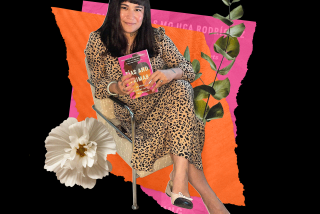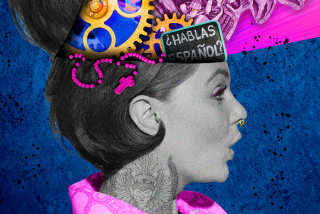Inside the World of Outsiders : Check your stereotypes at the door and step out with the Gypsies : BURY ME STANDING: The Gypsies and Their Journey, <i> By Isabel Fonseca (Knopf: $25; 322pp.)</i>
- Share via
No ethnic group on the European continent is as widely misunderstood and maligned as the Gypsies.
Stories about Gypsies rarely surface in the press, except when linked to crime or violence. Likewise, personal encounters with ragged children and haggard mothers in city squares from Moscow to Paris do little to inspire confidence. After forking over spare change, we scurry away, clutching tightly to our pocketbooks. Chances are slim we’ll ever meet the millions of law-abiding, scrupulously honest Gypsies who live in tidy, well-kept houses throughout Eastern Europe.
That’s why Isabel Fonseca’s book is so important. In “Bury Me Standing: The Gypsies and Their Journey,” Fonseca pries open our eyes and probes beyond the stereotypes as she takes us inside the secret and hidden world of a people who live “outside of history.”
A London-based journalist, Fonseca roamed Eastern Europe from 1991 to early in 1995 and gained access to a world that most people rarely encounter because the Gypsies, who have a deep fear of contamination by outsiders and a distrust of the non-Gypsy world honed by centuries of persecution, want it that way.
“You will never learn our language,” a Gypsy activist proudly told Fonseca. But she rose to the challenge and mastered rudimentary Romany--the Gypsy tongue. In Tirana, Albania, Fonseca lived with a Roma family--the word that the Gypsies widely use to refer to themselves--and marveled at the ritual cleanliness that consumed their daily lives. She spent time with nomadic, Kalderash Gypsies in Romania and assimilated, middle-class Gypsies in Bulgaria. In Moldova, she visited a Gypsy businessman who built a palace to flaunt his wealth but lived instead in a tent out back. In Slovakia, she met Gypsies so poor they lived in an abandoned arsenic mine.
Blending personal anecdote and observation with historical research--some of it from untranslated 19th-Century Balkan sources--Fonseca has produced a remarkable, captivating book whose title springs from something a Romanian Gypsy advocate told her: “Bury me standing, I’ve been on my knees all my life.”
The Gypsies came to exert a powerful hold on Fonseca, just as they have on an obsessed coterie of scholars and Gypsy advocates worldwide. But despite the warmth she feels for her subject matter, Fonseca is no PC Pollyanna. She finds humor in an American Gypsy who warns a colleague to “watch his pockets” during a visit to a Slovakian Gypsy slum. A glue-sniffing boy prostitute at the Sofia train station is described as “continually scratching himself and winking with ticks, he seemed incapable of any recognizable emotional response; he was a child but his eyes were divested of innocence. He was other.”
Fonseca also confronts stereotypes about Gypsies, who number 12 million, up to three-quarters of whom cluster in Eastern Europe. Were they rootless by nature or, as Fonseca suggests, because they were barred by law from owning land and entering certain professions (much as the Jews)? Are most Gypsies illiterate because they lack respect for education or because they were often labeled unteachable and put in classes for the retarded? Likewise, Fonseca points out that communism’s attempts to settle Gypsies helped kill off traditional skills such as ironsmithing and horse trading. Unable to roam and ply their trades, many turned to thieving and begging. “Their survival, over a millennium, has depended on secrecy: on disguise and misrepresentation, on keeping customs and ambitions hidden, on burying the past--on lying. The Gypsies have always been partisans,” Fonseca writes.
Complicating the mix is the Gypsy belief that gadje, or non-Gypsies, are mahrime, or polluted, and that unnecessary contact with them can lead to ritual contamination. Yet Fonseca was welcomed generously by the families she stayed with. Her Gypsy mother in Albania called her chey, or daughter. Nonetheless, “I was never allowed to prepare food, to work, to contribute as a daughter would. . . I would always remain a gadji. “
Fonseca recounts how historically, Gypsies who consorted with gadje or revealed secrets outside the clan risked exile--the worst punishment Gypsies can fathom. This is what happened to singer/songwriter Papusza after her songs were published in a Polish literary magazine in 1950. Papusza sang of the “lungo drum,” life on the road, which was already vanishing in her day: “No one understands me/Only the forest and the river/That of which I speak/Has all, all passed away/Everything has gone with it--/And those years of youth.”
Unlike Papusza, Fonseca’s writing is more documentary than lyrical. I would have preferred more evocative writing at times, but perhaps she made a conscious effort to avoid language that might romanticize the Gypsies. Still, that is a quibble in a book crammed with insight. I had no idea that most of the children in the wretched Romanian orphanages were Gypsies. That Gypsies have no creation myth or sense of a historic past. That fortunetelling is done exclusively for the gullible gadje . That more Gypsies live in Romania than elsewhere because they were imported as slaves and remained chattel until 1856.
Fonseca also notes that although an estimated 500,000 Gypsies died in the Nazi Holocaust (Gypsy scholar Ian Hancock says the figure is 1.2 million), their story is not known or commemorated. Only Jews and Gypsies were exterminated by the Nazis on the basis of ethnicity, but while the Jews have created a cult of remembrance, the Gypsies have made a widely successful effort to forget, Fonseca found. In most Gypsy enclaves, the communal memory dates back only as far as the oldest living person.
Fonseca explains how Gypsies are thought to have come from India in the 9th Century via Persia and Armenia, then Syria and Byzantine Greece. They appeared in Europe in the late 1300s as pilgrims and fortunetellers and were mistaken for Egyptians, which gave rise to the appellation Gypsy .
Throughout this book runs a note of warning. By documenting past atrocities and examining current ones--such as the Romanian peasants who, angered that their dark-skinned neighbors were “getting uppity” and rich, torched Gypsy villages as police stood by--Fonseca sounds the alarm that Europe’s most chronic outsiders are once again threatened. She quotes Czech President Vaclav Havel as saying that “the Gypsies are a litmus test not of democracy but of a civil society.”
Fonseca finds hope in the emergence of Gypsy race consciousness and ethnic politics as young Gypsies today reclaim their language and fight for equal rights and schooling. There are more Gypsy TV stations, newspapers, political parties and elected members of Parliament than ever before in Eastern Europe.
However, concludes Fonseca, “Beneath the surface things haven’t changed. The arrival of democracy in no way signals a reordering of Gypsy traditions. The secret society continues.”
More to Read
Sign up for our Book Club newsletter
Get the latest news, events and more from the Los Angeles Times Book Club, and help us get L.A. reading and talking.
You may occasionally receive promotional content from the Los Angeles Times.










